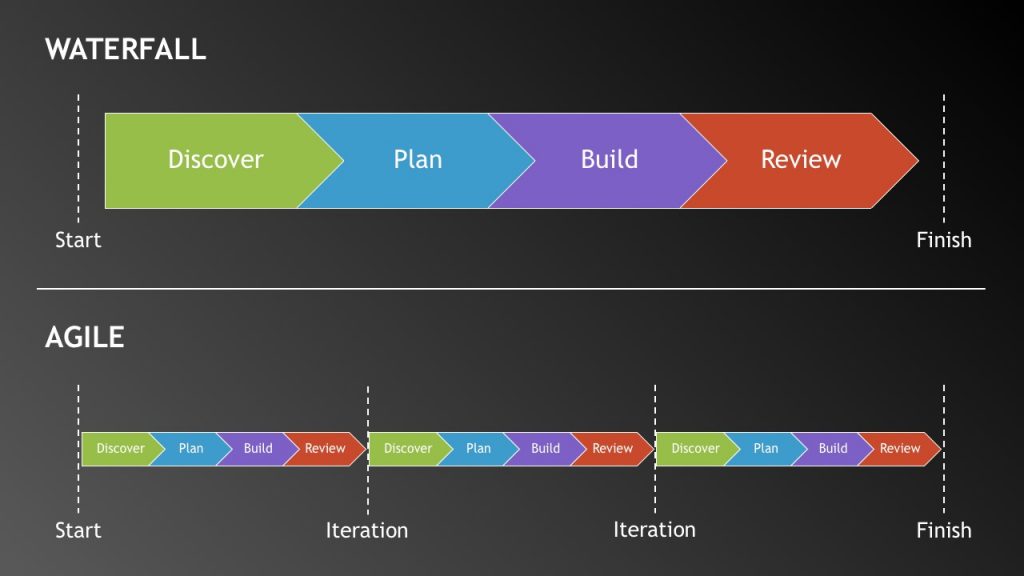Development Processes in Your Business – Part 2

In Part 1 of this blog, I discussed the two main development processes used by software developers: waterfall and agile. In this post, I’d like to explore how these processes are relevant to business operations, not just software development.
It would be convenient to say that all businesses should adopt agile development processes. However, that would be an oversimplification. Different areas have varying complexities and needs that justify different approaches.
A great example of this can be found in manufacturing processes.! business group I am part of had the privilege of touring the Ruger factory in Prescott, AZ. Regardless of your stance on guns, there is much to be learned from their manufacturing processes.
In the past, Ruger manufactured products in large lots, which created several issues with quality control, cost management, and efficiency. To address these issues, they transitioned to lean manufacturing, where a part essentially moves down an assembly line from start to finish. This approach increased efficiencies, allowed for quicker recognition of quality issues, and reduced on-hand inventory costs. However, they encountered a problem. Certain parts of their processes naturally lent themselves to larger lots, such as heat treating metal or sending parts to third parties for processes they didn’t handle in-house.
As they continued to evolve their processes, they found a way to blend the newer lean methods with the more traditional lot-based processes where it made sense. This flexible, hybrid approach allowed them to experience the best of both worlds.
In our businesses, certain processes lend themselves to be chunked up into smaller, bite-sized pieces that can be handled and developed independently. Other processes, however, are more complex and cannot or should not be sliced up. Often, a hybrid approach makes a lot of sense.
When looking at candidates for agile processes, in general, good targets are things that are iterative improvements to something that is already in place. Examples of this might be standardizing e-mail signatures, adding a piece of data collection in a database, etc. In these smaller examples, we can focus on the need, develop a solution for it, and release that solution rather quickly, with confidence. After we make the change, if something needs to be tweaked, it can usually be easily adjusted.
When looking at candidates for waterfall processes, more comprehensive projects, such as revamping the naming scheme of your document structure or altering the workflow of orders through your procurement, delivery, and billing system, are much more suited for a waterfall-style process. These projects require a lot more thought and involvement throughout your entire organization. They also need to go through more comprehensive evaluation processes before they are deployed because they will be much harder to tweak once they are in place. Imagine redefining your entire order workflow only to realize that someone forgot to consider how procurement and accounting would communicate. That could require a complete revamp of the process. Because of this, it makes sense to be more methodical and intentional in the process.
In the middle lies the more hybrid approach that, I find, works more often than either extreme does. In the example of the ordering workflow project, you might start by backing up and reviewing what is currently in place. Then, as a team, work to define what the process should look like. This might expose some different deficiencies in different areas that need to be remedied before the more comprehensive solution can be put into place. This is a great place where each individual area may apply agile processes to make iterative improvements, fix deficiencies, and prepare themselves to more readily align with the bigger revamp. From there, you might be able to make slightly bigger changes that revamp, for example, how sales and procurement work together or how the warehouse and delivery work together. As these improvements are completed, eventually, there comes a time when the waterfall release of the entire revamp makes sense and the new workflow is released in full.
In business, just like in software development, there is no one-size-fits-all approach. The key is to understand the unique needs and complexities of your operations and adopt a flexible approach that combines the best elements of different methodologies. By doing so, you can achieve greater efficiency, quality, and overall success.
How does your business handle continuous improvement and development? Are there ways that utilizing both the waterfall and agile methodologies could benefit your organization and both expedite and bring sanity to that continuous improvement?
